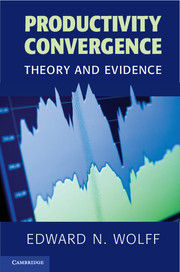Book contents
- Frontmatter
- Contents
- Acknowledgments
- 1 Introduction
- 2 An Overview of Modern Growth Theory
- 3 The Measurement and Estimation of Productivity Growth
- 4 Long-Term Record among the Advanced Industrial Countries
- 5 Postwar Record on Productivity Performance on the Aggregate Level among the Advanced Industrial Countries
- 6 Further Details on the Role of Education and Technology in the Productivity Performance among the Advanced Industrial Countries
- 7 Productivity Performance on the Industry Level among the Advanced Industrial Countries
- 8 The Productivity Slowdown
- 9 Postwar Economic Performance among Countries of the World
- 10 Recapitulation and Future Prospects for Growth
- Bibliography
- Index
8 - The Productivity Slowdown
Published online by Cambridge University Press: 05 June 2014
- Frontmatter
- Contents
- Acknowledgments
- 1 Introduction
- 2 An Overview of Modern Growth Theory
- 3 The Measurement and Estimation of Productivity Growth
- 4 Long-Term Record among the Advanced Industrial Countries
- 5 Postwar Record on Productivity Performance on the Aggregate Level among the Advanced Industrial Countries
- 6 Further Details on the Role of Education and Technology in the Productivity Performance among the Advanced Industrial Countries
- 7 Productivity Performance on the Industry Level among the Advanced Industrial Countries
- 8 The Productivity Slowdown
- 9 Postwar Economic Performance among Countries of the World
- 10 Recapitulation and Future Prospects for Growth
- Bibliography
- Index
Summary
The Earlier Literature on the Productivity Slowdown
The slowdown in the rate of productivity growth that occurred from about 1965 to 1979 in the United States spawned a considerable literature and was also a major focus of policy debate. Because of its enormous implications for the improvement of per capita well-being, a whole host of possible causes were diagnosed and a corresponding menu of remedies proposed. It should be noted at the outset there were wide differences of opinion both on the identity of the relevant factors and on their likely quantitative importance.
A few words should be said at this point about some of the causes of the productivity slowdown of the 1965–79 period. The main candidates, in the case of the United States, have included the following five factors: (1) slowdown in the rate of capital formation, (2) changes in the composition of the labor force, (3) energy price shocks, (4) declines in R&D spending (and/or the productivity of R&D), and (5) changes in the composition of output (mainly, the shift to services).
The next part of this chapter (Section 8.2) considers some measurement issues involved in the definition of productivity since this is germane to understanding some of the differences between the various studies. Section 8.3 presents estimates of the magnitude of the productivity slowdown both for the economy as a whole and for individual industrial sectors. Section 8.4 surveys much of the earlier literature on the subject. Section 8.5 considers more recent literature. Section 8.6 evaluates the relative merits of the arguments on the causes of the productivity slowdown put forth in the early literature on the subject and presents an evaluation of the later literature in light of the earlier research.
- Type
- Chapter
- Information
- Productivity ConvergenceTheory and Evidence, pp. 313 - 340Publisher: Cambridge University PressPrint publication year: 2013
- 3
- Cited by

